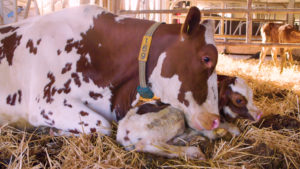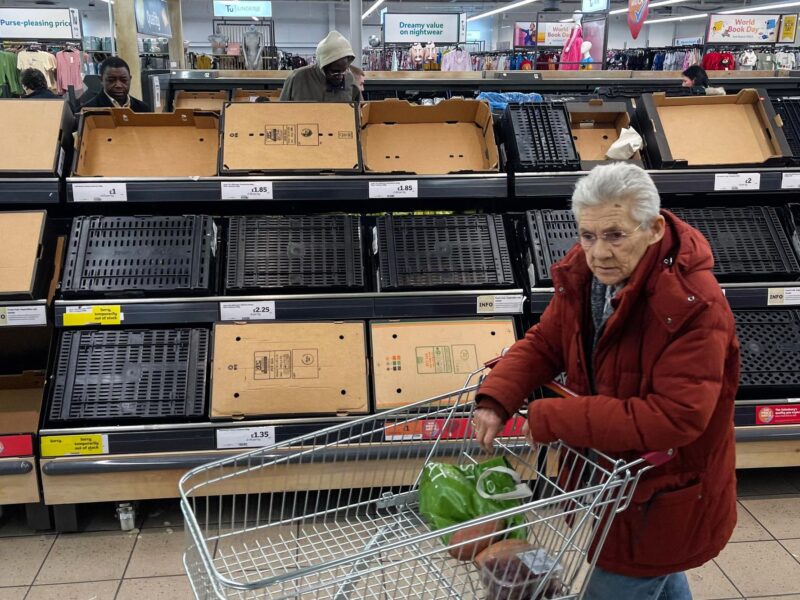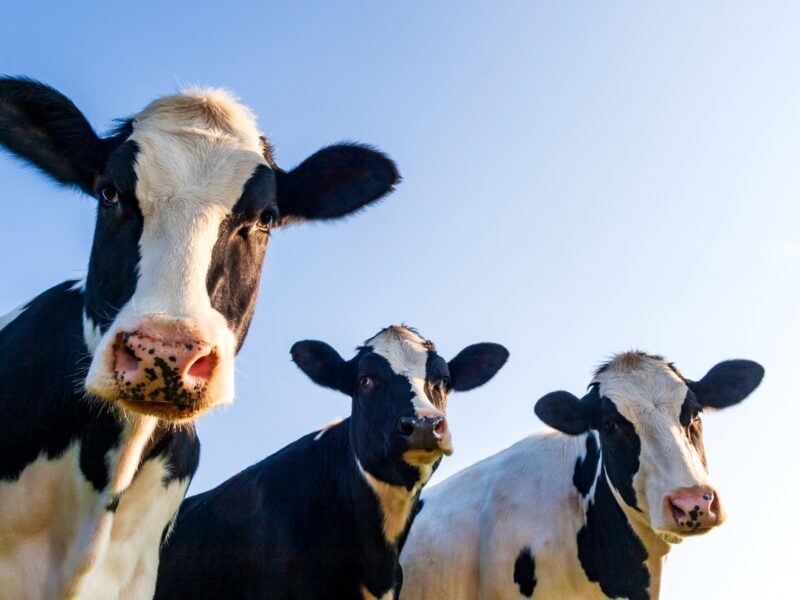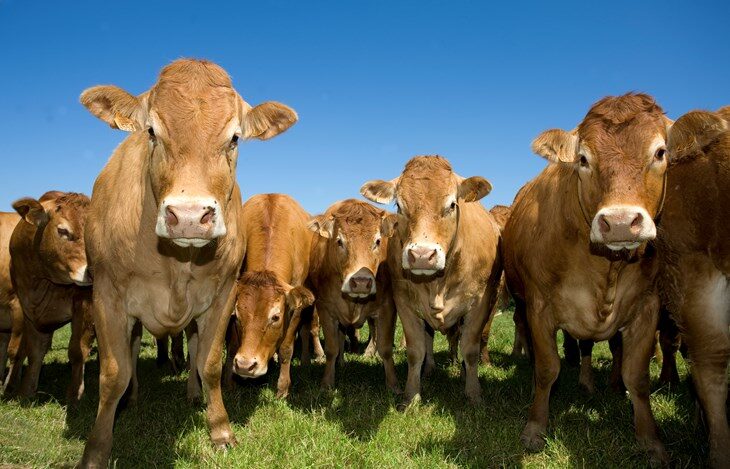
The Moral Maze of Milk

Is your milk trashing the planet?
I was recently faced with a dilemma; I found myself lost in the moral maze of milk. I’d come face-to-face with the reality of both the dairy industry and how crops like soya are produced.
There is no question in my mind that plant-based milks are better for animal welfare than dairy; after all, there’s no animals involved; but what are they doing for the environment?
I decided to find out.
The question has a long-standing relevance for Compassion in World Farming as our founder, Peter Roberts, was an early pioneer, importing soya as an alternative to meat. Way back in the 70s, his company, Direct Foods, was selling a range of plant-based innovations made from soya, including ‘Sosmix’ and ‘Sizzles’, the latter mimicking the smoky taste of bacon.
A former dairy farmer, Peter was a visionary; inspired by his vision, I wrote a book, Farmageddon: The true cost of cheap meat.
Whilst writing that book, I saw a lot of mega-dairies, not least in California’s Central Valley, where it’s commonplace to confine up to 12,000 cows to a single muddy pen, not a blade of grass in sight. A typical intensively-farmed cow is bred to produce so much milk that, in peak lactation, her body performs the metabolic work equivalent to a human jogging a marathon every day.
Keeping them in grassy fields is better for cow welfare, providing fresh air and sunshine, allowing natural behaviours and a more natural diet. Keeping cows on grass reduces the scope for pushing cows beyond their natural limits in pursuit of ever-more milk.
There is no doubt that pasture-based dairying is better for animal welfare than mega-dairies.
However, like almost all commercial dairy, it relies on breaking that most basic bond of the mammal kingdom: between mother and offspring. To give milk, a cow first has to be made pregnant and have a calf. The calf is then taken away at birth so the dairy can have the milk.
Yuval Noah Harari, Professor at the Hebrew University of Jerusalem and author of international best-seller, Sapiens, recently described what this separation means to mother and calf: “To the best of our understanding, this is likely to cause a lot of misery, a lot of emotional pain, to both the mother and the offspring.”
Fuelled by a mix of animal welfare, as well as health concerns like the cholesterol content in dairy, consumer interest in alternative plant-based milks globally is rising rapidly. It’s cited as one of the moment’s top food trends. In the USA, by 2021, plant milks are expected to reach 40 per cent of the milk market.
According to industry analysts, this rise is down to a surge in ‘flexitarianism’.
The research director for market intelligence company, Packaged Facts, David Sprinkle, said: “Vegetarians and vegans together account for less than 15% of all consumers and their numbers do not grow very rapidly, but a growing number of consumers identify themselves as flexitarian or lessitarian, meaning that they’ve cut back on their consumption of animal-based foods and beverages. It is this group that is most responsible for the significant and ongoing shift from dairy milk to plant-based milk.”
Plant milks are made from a growing list of crops, with soya, almond, rice and coconut amongst the most popular.
Whilst they avoid animal welfare concerns, I still wanted to find out: are plant-milks trashing the environment?
I saw first-hand in Brazil how the industrial production of soya is expanding at the rate of hundreds of thousands of hectares every year, wiping out whole ecosystems.
I remember walking amongst waist-high grasses, past old, twisted trees and springy bushes. I remember hearing birds calling and insects pinging themselves skywards or scuttling away. There were jaguars around too, but I didn’t see them.
This was Emas national park, a rare pristine patch of Cerrado, the savannah grassland that once covered much of this interior landscape.
I remember it being like nature’s last stand; on one side of the road, a rich web of life; on the other, a vast prairie of uniform farmland; there were no hedges, no field boundaries; just one newly-planted patch of crop after another: soya.
The industrial soya in vast monocultures uses massive amounts of pesticides.
These wipe out wildlife, spraying away the insects and plants needed by birds, bats, bees and the complex ecosystem that leads to the jaguar.
I asked a leading biologist known as the ‘dean’ of jaguar conservation, Leandro Silveira, what all this means for big cats: “When you deforest the land and remove their prey species, even if you’re doing farming of soya bean and corn… you’re directly affecting the cat… You are silently wiping out the species”.
As well as wildlife declines, there is also a human tragedy unfolding: Brazil accounts for a fifth of the world’s pesticide use, almost half being sprayed on soya. On average, one person in Brazil becomes poisoned by pesticides every 90 minutes; every two and a half days, someone dies.
This tale of destruction is aggravated by the fact that despite soya being a wonder-crop, a complete source of protein for humans, the vast majority of it goes for animal feed. The European Union imports about 35 million tonnes of soya a year – nearly half from Brazil – much of it to feed Europe’s industrially-reared farm animals.
My time in Brazil made me stop and wonder: by drinking soya milk, was I fuelling this devastation?
Professor Raj Patel from the University of Texas, summed up the consequences of industrial soya by saying, “If you are vegetarian and you walk around with your halo of virtue, but you are eating tofu that comes from Brazilian soy, then you’re just as complicit in all of this as if you are eating the beef fed on Brazilian soy.”
What he’s getting at is that, as with many other crops, it’s not soya per se that’s the problem, but the way it’s produced, the industrial production.
If those crops were produced organically, without pesticides, with mixed rotational farming, on existing farmland rather than deforestation, then things would be better.
So, what about those cartons of soya milk and the like on supermarket shelves? How are they produced? Do they come from the deforested plains of South America?
Well, that’s becoming a bigger question as retail sales of soya and other plant milks continue to soar in Europe, rising by 12 per cent annually.
A scan of my local supermarket shelves in England revealed a clear leading brand: Alpro.
Alpro is now owned by the French multinational dairy giant, Danone.
According to the company’s customer information, it produces both organic soya milk, which it sells under the brand name, Provamel, and non-organic soya which is free from GM ingredients or soya from deforested areas. Half its soya is grown in Europe. The rest? From Canada
Most UK supermarkets offer soya milk under their own label, with Tesco, The Cooperative and Waitrose responding to my customer information requests to confirm that their soya too is non-GM and avoids rainforest deforestation, coming from Europe and Canada.
I also looked into one of Alpro’s competitors, Sojade (So Soya!), and found that they only use organic soya grown in France.
What I had discovered is that often readily-available soya milk doesn’t come from the deforested plains of South America.
But how does it compare with dairy on environmental criteria like climate impact, land use and pollution?
According to ‘Life Cycle Analysis’ data, which looks at various factors from field to fridge, soya milk needs 61 per cent less land than its dairy equivalent, produces 76 per cent less greenhouse gas emissions and is four times less water-polluting.
So, planet-conscious consumers wanting to avoid the animal welfare pitfalls of dairy, can, with care, choose environmentally-friendly soya milk by looking for non-GM, locally-sourced and preferably organic.
Another popular plant milk is almond.
I got a glimpse of the dark side of how almonds are grown whilst in California’s Central Valley.
I stood amongst the seemingly endless almond groves with my writing partner, Isabel Oakeshott, then of the Sunday Times newspaper. “Listen, just listen,” I said to Isabel. And do you know what we heard? Nothing. Not the chirp of a bird or the buzz of a bee. They had all gone.
What we did hear was the low thud of a distant helicopter spraying pesticides to keep nature at bay. It was all part of a daily chemical assault on the landscape; from aircraft, weird-looking land-craft and from men in protective suits.
No wonder then, that California’s crops now rely on an influx of 40 billion bees a year – on the backs of thousands of trucks – representing the world’s largest man-made pollination event.
After six weeks of buzzing about pollinating the crops, the bees are back on the trucks to be taken to the next eco-stricken state. And this in a state responsible for producing 80 per cent of the world’s almonds.
This was far from ‘organic’, a form of farming that requires little or no chemical pesticides.
It made me wonder, was almond milk a good thing?
Conventional almond production is heavy in pesticides and presents a trade-off between water use and climate; a litre of almond milk needs 17 times more water than dairy whilst greenhouse gas emissions were 10 times less.
I came across Blue Diamond ‘Breeze’ almond milk in my local supermarket. Their almonds are grown in orchards by a 3000-strong grower co-operative in California. None of their almonds are organic and they wouldn’t tell me what pesticides they used, but the company did tell me that they “abide by California regulations”, some of which I surmised I’d seen first-hand during my time in the sunshine state.
I looked at other almond brands in local supermarkets, Alpro again being amongst the most visible. Alpro says it’s working toward all of its almonds coming from the EU. Alpro’s organic brand, Provamel, already uses only organic almonds from Europe. Another prominent brand, Rude Health, also says its almonds are organic, mainly from Italy.
I decided to look at some less well-known plant milks.
Oat-milk swept to prominence recently when The Guardian featured a Swedish farmer, who switched from growing cereals for animal feed to crops for oat milk. The switch was supported by Swedish drinks company, Oatly.
Compared to semi-skimmed dairy, oat milk has 62 per cent less climate impact and uses half the energy.
So, plant-milks are on the rise, but could supermarket shelves of the future be dominated by a complete newcomer – fermented dairy, milk without the cow?
San Francisco start-up, Perfect Day, ferments cow DNA, plant nutrients and yeast to produce a product that tastes identical to cow’s milk.
The process is said to be “just like brewing craft beer”.
Compared to dairy from a cow, fermented milk has been found to cut climate impact by up to two-thirds, whilst reducing water and land requirements by more than 90 per cent.
So, from various permutations of dairy, through plant-milks of soya, almond and oat, to fermented milk without the cow, I emerged from the moral maze of milk with a clear sense anew; that plant-milks are better for animal welfare. But be choosy. Personally, I am now actively avoiding soya from South America and non-organic almonds from California. I try to buy organic plant-milk wherever I can.
Compassion in World Farming’s founder put his faith in plant-based milk as a cruelty-free alternative to dairy. He was right to do that. In being careful to avoid industrial monoculture crops, he was right on environmental grounds too.
As consumers, our choice of milk really does matter.
We all have the power to reduce an awful lot of farm animal suffering and save wildlife; by choosing more milk from plants, and less and better dairy from cows kept pasture-fed, free range or organic.
Now, I’ll raise a glass to that.





